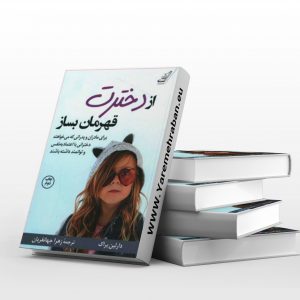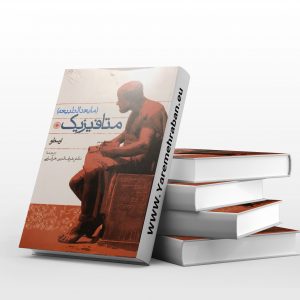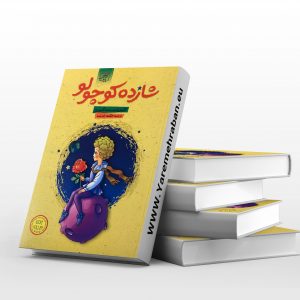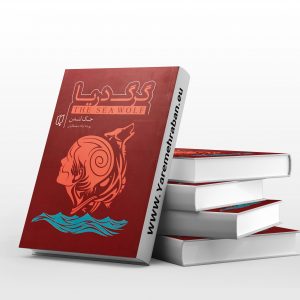Description
The year of the riot occurs in the first person in the mind of a woman named – Noshafarin – and it begins in such a way that we are thrown directly into the story. That is, the author does not go to the margins at the beginning of the book and introduces the reader directly into the main story. In the following, the mentalities and characters of the book of the year of the riot and the whole story will be revealed to us. The book of the year of the riot contains memories that are reviewed in the minds of the newcomers.
Nosha is the daughter of Colonel Niloufri. A colonel who has come to Sangsar (the place where the story of the book takes place) to climb the ladder of progress and decides to have a glorious future for his daughter, but…
But Nosha falls in love with a strange potter and dedicates his whole being to him. However, Destiny has made another decision for Nosha and…
At the heart of the book of the year of the riot is the legend of the goldsmith and the king’s daughter, which sometimes takes the audience away from the book altogether and paints a different world for him. A legend that is intertwined with the story of the book and shows this art of the author.
There are other main characters in the book of the year of the riot. Characters who each perform specific activities based on their own reasons. Among these we can mention the German Malcolm who intends to build a big bridge from the Mountain of the Prophets to Kafr Qala with a specific purpose.
The book of the year of the riot takes place in seven nights. Seven Nights which is narrated from the first person (Noshafarin) and the third person (the author himself).

About the book of the year of the riot
First of all, this novel is about the oppression of Iranian women. A woman who is not safe from masculine bullying, from the hardships of the time, and from the hazy eyes of men, and she must constantly be careful not to do anything that would provoke a man.
This can be seen in various parts of the book of the year of the riot, for example:
I raised my hands to repel the first blows of the Moser rifle. Masoom was holding a moser pipe and was pounding his heavy butt on my head.
I had forgotten that my daughter, and at that moment I did not think that when men stare at a man with that high mustache and shining eyes, from top to bottom and from bottom to top, the searching eyes that seem to be forcing He wants to pull back the tent and swallow it all at once, one melts out of embarrassment, melts, is squeezed in the hands of one person and falls to the size of a drop, check.
Capt. Khosravi said: “Yes, you said. “I talked to the tenant and told him I would cut your skin if you did not put the stone right on the scales.” And without taking his eyes off me, he drank his tea, put his glass on the table, and tapped his instruction several times.
“Drink,” said the mother. And a squint went to my thigh. I quickly covered my skirt and watched Captain Khosravi. It was as if he had rolled my skirt with his eyes and then stared with joy.
The book of the year of the riot addresses various topics. It deals with forbidden love and shows power-seeking well. Examines misogyny and shows how limited women are. And Abbas Maroufi has written all these things in a beautiful way in the book of the year of riots. In a way, each of these topics forms a piece of the story and the audience must put these pieces together like a puzzle and finally reach the main meaning of the story. This story is very attractive and reduces the reader’s fatigue.
The influence of Houshang Golshiri on Abbas Maroofi
The story of the novel Year of the Riot takes place during the Second World War and the rule of Reza Shah Pahlavi, and the author has well portrayed the political and social conditions of the country at this time in the form of this story. The use of time jumps in the story shows that Marufi has an exemplary genius under the influence of his teacher “Houshang Golshiri”.
In this book, Abbas Maroufi talks about various topics and depicts issues such as power-seeking, feminism and forbidden love in an effective way for the reader. Famous in the year of the riot, it gives the story to the reader like pieces of a puzzle to confront the audience with an unexpected ending.
Introducing the book of the year of the riot
Nosha is the daughter of Colonel Niloufari. A man who came to Sangsar city, which is now called “Mahdishahr” and is located in Semnan province, to build his daughter’s future.
But Nosha, who is seventeen years old, falls in love with a potter named Hosseina in the alley. The other character in the story, Dr. Masoom, is a middle-aged and very famous man who wants to drink, and this young girl has to choose between love and fame. But in the continuation of the story, we see that destiny wants something else for Nosha. The story is reviewed with disturbing and strange prose in the form of memories in Nosha’s mind.
Famous; Popular Iranian author
Abbas Maroufi was born in May 1983 in Tehran. He is an Iranian writer, playwright, poet and journalist, and studied “Dramatic Arts” at Tehran University of Fine Arts. Maroufi worked for several years as the literature secretary of various literary magazines in Tehran.
Abbas Maroufi was one of the students of “Houshang Golshiri”, a famous Iranian writer, and today he is as popular among literary audiences as “Golshiri”. The first work published by Abbas Maroufi is the collection of stories “Facing the Sun”. Marufi became famous with the publication of the book “Symphony of the Dead” in 1989.
“Symphony of the Dead” is one of the most popular works of contemporary Iranian literature, which was very well received by the audience and was reprinted several times. After the Symphony of the Dead, he wrote the famous novel The Year of the Riot, which made him a well-known writer among the people of culture and literature.
Over the years of his writing, he has presented works to his audience that each have their own unique characteristics. Other prominent works of Abbas Maroufi include “Farhad’s body”, “Collection of the story of the blue island sailors” and “The play of the pendulum of our memories”. The novels “Fereydoun had three sons”, “Totally special”, “Melted” and a collection of “Stories in front of the sun” and “Perfume of despair” and several other plays are the works of this author. Phoenix Publications is the exclusive publisher of Abbas Maroufi’s books.
Abbas Maroufi also had a hand in journalism. “Gardoon Magazine” was the title of a cultural, social and literary monthly, which was published in Tehran under the editorship of Abbas Maroufi since 1990. After the closure of “Gardoun” monthly in 1974, a famous person emigrated from Iran to Europe. He currently lives in Germany and manages the Berlin House of Arts and Literature.
Those who are interested in Iranian literature and the books of the famous Abbas can visit the Fidibo website to download the book (pdf) and its audio book and buy and download the book of the year of the riot.
Interpretation of the book of the year of the riot
Abbas Maroufi’s books were so influential in the minds of the audience that despite the dark atmosphere of the stories and playing with the times, they are still among the most recommended books in bookstores and bookstores. Most Iranian singers know Abbas Maroufi by the “Symphony of the Dead” and the year of the riot. Although The Year of the Trouble is a remarkable novel, some critics believe that the Symphony of the Dead is a masterpiece by this powerful author.
These two famous works of the author have a lot in common. One of these commonalities is the symbols that Maroufie has used to describe the social and cultural conditions of the period, with the difference that this time in the year of the riot, the main victim of the novel is a woman.
The year of the riot has marked the oppression, outrage and isolation of women. This book was able to depict the patriarchal atmosphere of the time of the story well. The Year of the Riot is the story of a woman who is not safe from the tyranny and oppression of the men of her time, from traditions and even short-sighted decisions.
In a part of the story of the year of the riot, the author refers to the forgetfulness of women in the corners of houses and in a masterful way expresses the role of this issue in changing the society of that period in the heart of a love story.
The publisher has written a detailed review of this book. In one part of this critique, it is stated: “One of the remarkable points in the critique of the book of the year of the riot is the use of different symbols. “Hair” is one of the symbols that has been used for meaning and concept in the story. The author has used this element in different parts of the book, contrary to its true meaning in the world of literature.
The mythical concept of hair says that sacrificing hair means helping the god of fertility, but in this famous book he uses the contradiction and the reader does not see any trace of fertility and abundance in this cursed city. “Marufi describes the hair of the two characters Hosseina and Masoom to the reader in the language of Nosha. From the very first meeting with both characters, he is influenced by their hair and expresses his description of their hair.”
Characterization in the famous novel of Abbas Maroofi
The characterization of the book of the year of the riot is done in a skillful way and the author shows their characteristics in such a way that the audience can easily access the intellectual flow of the characters. It can be said that combining historical myths with today’s world is a famous trick that he did well in the year of the riot. The author sometimes takes the audience to another space of the story and shows them a different world, which shows the famous mastery and genius in writing.
We read in parts of the book of the year of the riot
Someone was to be hanged. Someone who had lost the war. I did not know who that person was. At night, when I saw that Masoom was not at home, I went to the house of my neighbor, Roghayeh Dalal and Nazo.
There were three men in front of them. Roghayeh forced Dalal Nazo to sleep with the old man who was there. Masoom had just resented me and I did not know why. What dreams did I have in my heart at my wedding and they were all gone. I remember when I got married he loved me so innocently that we did not leave the house for a month and we were happy together. Before I married Masoom, Captain Khosravi proposed to me, but my mother refused.
After marriage, I learned weaving from Dr. Masoom Jajim مادر’s mother. Dr. Masoom ran away from home as a child and came to Tehran and engaged in various jobs. Later, he went to England with a Qajar prince and studied medicine and returned to Sangsar with his mother.
When I got engaged to Masoom, one day I left the house and Hosseina was working as a potter in her shop. Hosseina kissed me in her room that day. Hosseina had made a statue of Shirin and Farhad in her room. He told me again that he was looking for his brothers Siavshan and Ismail. He knew that Dr. Masoom had come to propose to me.
I did not like Masoom and I wanted Hosseina. I told my mother when I got home. My mother did not accept. My mother did not know that I had lost my hand because of Hosseina. God, I prayed that he would not understand the innocent wedding night. One day Hosseina proposed to me in a black striped suit and white shirt. My mother asked him if he knew how to read and write, and he said that he had read Khamseh Nezami.
1- Introducing the book on YouTube
2- Introducing the book in Aparat














Reviews
There are no reviews yet.